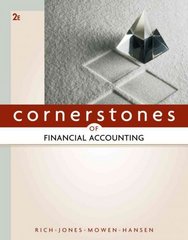i need part c through e

8. Considering the following quarterly prices and dividends for two share classes for Bank of America Corporation for the period December 2015-March 2017: Common Shares Preferred Shares (BAC) (BAC-D) Qir. End Date Price Dividend Price Dividend Mar-17 23.59 0.075 25.22 0.39 Dec-16 23.09 0.075 24,58 0.39 Sep-16 15.65 0.075 25.74 0.39 Jun-16 14.49 0.05 25.81 0.39 Mar-16 13.52 0.05 25.4 0.39 Dec-15 16.83 0.05 25.49 0.39 (a). Calculate the quarterly holding period returns for each share class from January 2016 through March 2017. Hint: Assume the beginning of quarter price is the price from the last quarter (so the beginning share price for the quarter ending March 2016 is from December 2015). Note: Do these and the remaining calculations in this problem explicitly, ie, not by using Excel formulas, (b). Calculate the arithmetic average return for both share classes. 5.5 Measuring Charteristics of Risky Asser Returns 135 - (C). Calculate the average quarterly holding period return (geometric average) for both share classes (d). Calculate the total (cumulative) 5-quarter holding period return for both share classes. Which share class offered the better return? (e). Calculate the variance and standard deviation of the quarterly holding period return for each share class. If the quarterly risk-free return over this period was 0.05% (that is five basis points, not 5%!), what is the Sharpe Ratio (reward-to-risk ratio) for each share class. Which one has the higher Sharpe Ratio? 8. Considering the following quarterly prices and dividends for two share classes for Bank of America Corporation for the period December 2015-March 2017: Common Shares Preferred Shares (BAC) (BAC-D) Qir. End Date Price Dividend Price Dividend Mar-17 23.59 0.075 25.22 0.39 Dec-16 23.09 0.075 24,58 0.39 Sep-16 15.65 0.075 25.74 0.39 Jun-16 14.49 0.05 25.81 0.39 Mar-16 13.52 0.05 25.4 0.39 Dec-15 16.83 0.05 25.49 0.39 (a). Calculate the quarterly holding period returns for each share class from January 2016 through March 2017. Hint: Assume the beginning of quarter price is the price from the last quarter (so the beginning share price for the quarter ending March 2016 is from December 2015). Note: Do these and the remaining calculations in this problem explicitly, ie, not by using Excel formulas, (b). Calculate the arithmetic average return for both share classes. 5.5 Measuring Charteristics of Risky Asser Returns 135 - (C). Calculate the average quarterly holding period return (geometric average) for both share classes (d). Calculate the total (cumulative) 5-quarter holding period return for both share classes. Which share class offered the better return? (e). Calculate the variance and standard deviation of the quarterly holding period return for each share class. If the quarterly risk-free return over this period was 0.05% (that is five basis points, not 5%!), what is the Sharpe Ratio (reward-to-risk ratio) for each share class. Which one has the higher Sharpe Ratio









